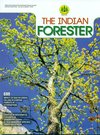Contribution to Biodiversity Hotspot: Assessment of Forest Types, Floristic Composition and Economic wealth of Nokrek Biosphere Reserve in Northeast India
DOI:
https://doi.org/10.36808/if/2018/v144i8/132338Keywords:
Nokrek Biosphere Reserve, Forest Types, Species Diversity, Economic Taxa, Hotspot, Himalaya.Abstract
Himalayan ecoterrains are globally known as hub and store house of Asian endemic taxa, and the diversity within ecosystems varies from tropical to alpine meadows. Investigation on assessment of vegetation compositions, forest types and floristic analysis of Nokrek biosphere reserve (NBR) in Northeast India were carried out in eight successive years between 2007 and 2015. Two hundred line transects were laid down randomly of 50m x 10m and in total 1406 species 6 subspecies 8 varieties of957 genera and 155 families identified from NBR. Out of the total species studied, 991 species are dicotyledons, and 294 species are monocotyledons. In addition, 113 species of lycophytes and ferns and 8 species of gymnosperms are also documented. In terms of species diversity, Orchidaceae is the most dominant family represented by 141 species, followed by Poaceae (91 spp.), Euphorbiaceae (56 spp.) and Rubiaceae (54 spp.). The present communication deals with information on forest types, floristic compositions and economic valued plants of NBR. Jhum cultivation, coal mining and lime stone extraction are the main human activities exploiting the natural ecosystem of this biosphere reserve. This research will be helpful in formulating future conservation strategies for endangered taxa of Nokrek and adjoining areas.References
Baishya A.K. and Rao R.R. (1982). Ferns and Fem-allies of Meghalaya State, India. Scientific Publisher, Jodhpur, India.
Bora P.J. and Kumar Y. (2003). Floristic Diversity of Assam: study ofPabitora Wildlife Sanctuary. Daya Publishing House, Delhi, India.
Champion H.G. and Seth S.K. (1968). A revised survey of the forest types of India. Natraj publishers, Dehradun, India.
Daniel P. (2005). The Flora of Kerala. Published by Botanical Survey of India, MoEF, Salt Lake Kolkata, India.
Fosberg F.G. (1961). A classification of vegetation for general purpose. Trop. Ecol., 2:1-28.
FSI (2013). State of Forest Reports. Forest Survey of India, Dehradun, India.
Grimmett R., Inskipp C. and Inskipp T. (1999). A pocket guide to the birds of the Indian subcontinent. Oxford University Press, Delhi, India.
Haridasan K. and Rao R.R. (1985-1987). Forest Flora of Meghalaya, 2 vols. Publisher Bishen Singh Mahendrapal Singh, Dehradun, India.
Hooker J.D. (1872-1897). The Flora of British India, 7 vols. L. Leeve & Co., London.
Kamble M.Y. and Yadav S.R. (2004). Asclepiadaceae of Maharashtra. Bull. Bot. Surv. India. Published by the Director Botanical Survey of India, Kolkata, India.
Kanjilal U.N., Kanjilal PC., Das A., De R.N. and Bor N.L. (1934-1940). Flora of Assam, 5 vols. Publisher Government Press, Shillong, India.
Karthikeyan S. (2000). A statistical analysis of flowering plants of India. In: Flora of India (Singh N.P., Singh D.K., Hajra P.K. and Sharma B.D. eds.). Botanical Survey of India, Kolkata, India.
Kataki S.K. (1986). Orchids of Meghalaya. Government of Meghalaya, Shillong, India.
Kumar K.M.P., Ashish G.R., Sabu M. and Balachandran I. (2013). Significance of gingers (Zingiberaceae) in Indian System of Medicine Ayurveda: an overview. Anc. Sci. Life, 32(4): 253-261.
Mao A.A. and Kharbuli P. (2002). Distribution status of Nepenthes khasiana Hook.f.-a rare endemic pitcher plant of Meghalaya, India. Phytotaxonomy, 2: 77-83.
NairV.J. and Murthy G.V.S. (2012). Bibliography of Indian Poaceae. Botanical Survey of India, Kolkata, India.
Rao A.S. and Verma D.M. (1982). Cyperaceae of North East India. Botanical Survey of India, Howrah, India.
Shukla U. (1996). The grasses of North Eastern India. Scientific publishing Jodhpur, India.
Singh B. (2015). Himalayan Orchids- Distribution and Taxonomy. Write & Print Publications, New Delhi, India.
Singh B. and Borthakur S.K. (2012). Phenology and Geographic Extension of Lycophyta and Fern flora in Nokrek Biosphere Reserve of Eastern Himalaya. Proc. Nat. Acad. Sci. India Sec. B: Biol. Sci., 85(1): 291-301.
Singh B., Borthakur S.K. and Phukan S.J. (2014). A survey on ethnomedicinal plants utilized by the indigenous people of Garo Hills with special reference to the Nokrek Biosphere Reserve (Meghalaya), India. J. Herbs Spices Med. PI., 20(1): 1-30.
Singh B., Phukan S.J., Sinha B.K., Singh V.N. and Borthakur S.K. (2011) . Conservation Strategies for Nepenthes khasiana in the Nokrek Biosphere Reserve of Garo Hills, Northeast, India. Inter. J. Conserv. Sci., 2 (1): 55-64.
Singh B., Singh V.N., Phukan S.J., Sinha B.K. and Borthakur S.K. (2012) . Contribution to the pteridophytic flora of India: Nokrek Biosphere Reserve, Meghalaya. J. Threat. Taxa, 3(12): 2277-2294.
Singh B., Sinha B.K., Phukan S.J., Borthakur S.K. and Singh V.N. (2013) . Wild edible plants used by Garo tribes of Nokrek Biosphere Reserve in Meghalaya, India. Indian J. Tradit. Know., 11(1): 166-171.
Singh J.N. and Singh K.P. (2002). Nokrek Biosphere Reserve. In: Floristic Diversity and Conservation Strategies in India (eds.) by Singh N.P. and Singh K.P, Botanical Survey of India, Kolkata, India.
Downloads
Downloads
Published
How to Cite
Issue
Section
License
Unless otherwise stated, copyright or similar rights in all materials presented on the site, including graphical images, are owned by Indian Forester.





